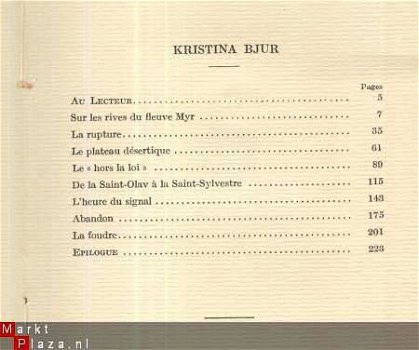
ARVID MÖRNE**KRISTINA BJUR**FINNISH-SWEDISH POET.
Kenmerken
- Conditie
- Gebruikt
- Levering
- Niet van toepassing
Omschrijving
ARVID MÖRNE
Arvid Mörne (1876-1946) was a Finnish-Swedish poet and literature scholar. Mörne's poetry was mainly inspired by the archipelago of the Gulf of Finland, the sea and the coastal regions inhabited by Finland's Swedish-speaking population, especially in the province of Uusimaa. His works also voice his political views, the call for a social sense of justice.
**KRISTINA BJUR **
TRADUIT DU SUEDOIS PAR TURIL TOVE
COLLECTION **TRADUCTA**
OFFICE DE PUBLICITE S.C.
ANC. ETABL. J. LEBEGUE & Cie
36,Rue Neuve, BRUXELLES 1943
ARTICLE INVENTAIRE CODE 5.030
FORMAT 205 X 140 X 23 + 229 + 300 GRS
EXPED. EN BELGIQUE 2,35 EURO
**FEW PEOPLE THINK MORE THAN 2 OR 3 TIMES A YEAR.
I HAVE MADE AN INTERNATIONAL REPUTATION BY THINKING ONCE OR TWICE A WEEK.**dixit GEORGE BERNARD SHAW
The first printed work in Finnish was the ABC book published c.1542 by Bishop Michael Agricola (1508–57). In 1642 the first complete translation of the Bible in Finnish appeared in Stockholm. Until the 19th cent. most of the writing done by Finns was in Swedish, since from the 13th cent. to 1809 Finland was in political vassalage to Sweden. The linguistic researches of Alexander Castrén (1813–53), as well as the historical writings of Henry Gabriel Porthan (1739–1804) and the publication (1835) by Elias Lönnrot of the Kalevala, helped to feed interest in Finnish as a literary vehicle. Still many continued to write in Swedish, among them Zacharias Topelius and J. L. Runeberg, the national poet of Finland. Others who preferred Swedish were the romantic novelist Topelius; Arvid Mörne (1876–1946), poet, novelist, and playwright; Jarl Hemmer, poet; and the prose writer Runar Schildt (1888–1925). To the first generation of those writing in Finnish belong the novelist Pietari Päivärinta (1827–1913) and Alexis Stenvall (pseud. Kivi, 1834–72), who originated Finnish tragic and comic drama. He is known abroad for The Seven Brothers (1870, tr. 1929), a masterpiece combining elements of romanticism and realism. Eino Leino (1878–1926), Finland’s most original lyricist, produced some 30 collections of poetry reflecting the influence of folklore. The poet Edith Södergran (1892–1923), inspired by the European symbolists and by her Russian childhood, had great influence on modern Finnish and Swedish poetry. The first Finnish writer to express modern realism was the playwright and champion of women’s rights, Minna Canth (1844–97). Also influenced by realistic as well as radical literary currents in the 1880s was Juhani Aho (1861–1921), a novelist who gave literary Finnish a new maturity and artistic standard. The novelist and poet Ilmari Kianto depicted the bitter struggle for existence among the poor peasantry in N Finland. Also concerned with rural life were the novelists Joel Lehtonen (1881–1934) and Pentti Haanpää (1905–55). A champion of social reform was the Swedish-language poet Arvid Mörne. The conflicts rising from the civil war (1918) inspired the playwright and short-story writer Runar Schildt. The tensions of 20th-century industrial society are reflected in the novels of Toivo Pekkanen (1902–57). Frans Sillanpää, who won the 1939 Nobel Prize in Literature, gained fame for his lyrical impressionist novels. Dominating Finnish literature in the mid-20th cent. were the novelist Väinö Linna and the prolific novelist, poet, and playwright Mika Waltari.
1
See P. I. Ravila, ed., Finnish Literary Reader (1965); A. Rubulis, Baltic Literature (1970); J. Ahokas, A History of Finnish Literature (1972).


















